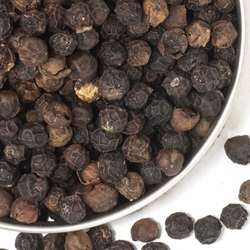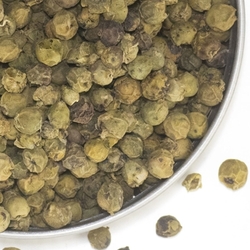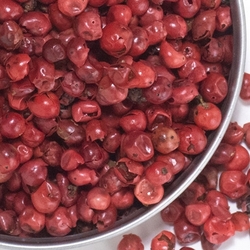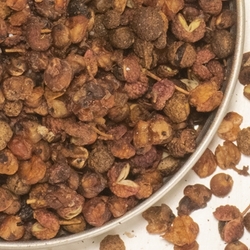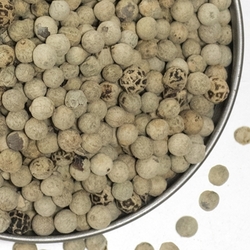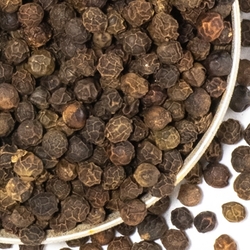Spice Cabinet 101: Peppercorns
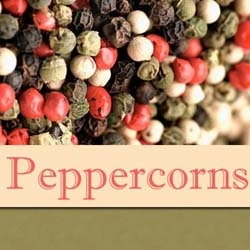
Spice Cabinet 101: Peppercorns
Pepper is one of the two spices that can be found in almost every kitchen in America. The first being salt and the second being pepper. Pepper sits in your pepper shaker or pepper mill just waiting to be ground and it can be used to season hundreds of different foods. But many people don't know the remarkable story behind these tiny peppercorns that are bursting with flavor.
Peppercorns are one of the more interesting categories of spices. This is because the name peppercorns is more of an umbrella term for a small variety of spices which share the same shape, size and peppery flavor. Although they have these similarities, their differences vary and make them each equally interesting.
Table of Contents
Black Peppercorns
Black peppercorns, also known as Piper nigrum, are the fruit of a flowering vine in the Piperaceae family. These vines begin producing fruit at three years and die down around the fifteenth year. Each vine produces spikes which contain 50 or more berries, or drupes. Each spike ranges from 4 to 8 cm when the drupes appear and grow to be 7 to 15 cm as the fruits mature. These berries, or peppercorns, are also known as pepper or black pepper. Black peppercorns are actually the unripe green fruit of the plant. The most common process of creating black peppercorns is to boil them after they have been picked and then use heat to dry them. On some estates, the peppercorns are not boiled first, but only dried by the sun. The heat used in this process fractures the cell walls and turns them brown. You may note that black peppercorns also have a wrinkled appearance. This is because the walls of the peppercorns absorb aromatic compounds as they dry.
Black peppercorns have a distinct spiciness. Unlike chile peppers that get their heat from capsaicin, peppercorns get their spiciness from a derivative called peperine. Peperine stimulates your taste buds, therefore enhancing the flavors of food. It also increases saliva production which is why pepper may be linked to improved digestion.
Black peppercorns are native to south India and are currently grown in other tropical regions as well. Today, Vietnam is the top producer and exporter of black peppercorns. When many people think about the pepper that is sitting on their kitchen table, they may not realize the intricate back story that it carries. One of the most important producers of black peppercorns is the Malabar Coast of India and they have been used in Indian cooking since 2000 BC. In India, black peppercorns were so highly prized that they were used as a form of money, calling them "black gold". These Malabar black peppercorns are the perfect every day pepper.
Lampong peppercorns are from Indonesia. These peppercorns are picked early in the ripening process and therefore are very small compared to Malabar peppercorns and have a sharpness and moderate level of heat. Their aroma is sweet and smoky with woodsy undertones. Lampong peppercorns work very well in Thai dishes and compliment coconut milk and lemongrass.
Not much attention has been paid to Vietnamese peppercorns in the past, but as Vietnam becomes the top producer of peppercorns in the world this is likely to change. These peppercorns are large in size compared to Malabar peppercorns and have a citrusy aroma and medium bite. The heat that is experienced with these peppercorns is more in the sinuses than the mouth which makes it a unique peppercorn. The lemony aroma of Vietnamese peppercorns makes them an excellent choice to use on fish or a salad.
Madagascar peppercorns come from the island of Madagascar, which used to be a French colony. Because of the close ties between Madagascar and France, these peppercorns are a favorite of French chefs and are the only type of black peppercorn that many French chefs will use. These peppercorns are small to medium in size and range in color from brown to tan. Their aroma is very smoky which makes them a good addition to meat dishes. Madagascar peppercorns are extremely hard to find because they are almost exclusively exported to France.
Tellicherry peppercorns are grown in the city of Tellicherry on the Malabar Coast of India and are considered the highest quality peppercorn in the world. These berries are left on the vines longer in the ripening process which produces peppercorns that are large with a milder flavor, but more complex pepper aroma. Farmers of Tellicherry peppercorns must be very educated and experienced to manage the tricky balancing act involved that allows for a complete development in the flavor and size of the berries on the vine without allowing sugar content to rise to where losses will occur from spoiling. The flavor can range from fruity to grassy to citrusy or piney, but overall they have an extremely bright and fresh flavor. This balanced flavor makes Tellicherry peppercorns a great stand alone pepper that can be used in almost any dish.
White Peppercorns
White peppercorns come from the same vine that produces black peppercorns. The difference between these peppercorns is the time that they are picked and the process that is used in cultivation. White peppercorns are picked much closer to the time of ripening than black peppercorns, when they are yellowish red or red in color. Once the berries are picked they are stripped of their outer hull either before or after drying.
Sarawak peppercorns come from the island of Borneo, which is in the state of Sarawak, in Malaysia. These peppercorns are stripped of their outer hull by being placed under water in a constantly flowing stream. These peppercorns have a musty, earthy aroma and work well when paired with strong flavors such as crabs and clams.
Muntok white peppercorns are grown on the Indonesian island of Bangka. These peppercorns are handpicked by pepper farmers who use traditional bamboo tripods to reach the top of these vines. After the berries have been collected they are placed in rice sacks and allowed to soak in a stream of water that has run down from the mountains. After about 7 days, the outermost skin has fallen away and the berries are then dried.
Penja peppercorns are grown in the Penja valley of Cameroon, where the fertile volcanic soil promotes the growth of the peppercorn vine. Although the wet, hot climate should be ideal for peppercorn growth, only a limited supply is cultivated. All white peppercorns that are grown in this area are exported to France. Because of this, Penja peppercorns are more difficult to find and more expensive than Sarawak and Muntok peppercorns.
The type of White Peppercorn that is most common in the United States comes from India. Like Malabar Black peppercorns, these white peppercorns are extremely high quality. They possess a sharp, winey and bitter flavor profile and work well in pickling brines and marinades.
While black peppercorns are used more often in American kitchens, the use of white pepper in dishes comes from French influence. The French use White pepper in a variety of dishes where Americans would typically use black pepper including white sauces, white gravy, mashed potatoes and any other light colored dish that would be enhanced by some peppery flavor. Using white pepper in these dishes creates a flavorful dish while being consistent in color.
Green Peppercorns
Green peppercorns are the closest relative to black peppercorns. They are both the unripe fruit of the same vine. Unlike the heat drying process used to create black peppercorns, green peppercorns are preserved using a process which includes boiling and then treating them with potassium sulphite. After this they are either dehydrated or frozen. Fresh green peppercorns can also be preserved through pickling. Pickled green peppercorns are most popular in France and are used to flavor a variety of French dishes such as sauce au poivre vert, flavored mustards, steak and pork.
In recent years, Brazil has become the top producer of green peppercorns. They are considered the highest quality in appearance and taste and therefore come with a higher price point. Green peppercorns are also grown in India.
Green peppercorns are prized for their fresh and spicy flavor. It is most comparable to parsley with a fiery kick. Green peppercorns can be used in place of black peppercorns if needed, but they really shine when combined with soups, salads, creamy sauces and wild game.
Pink Peppercorns
Pink peppercorns, unlike the other colors of peppercorns, do not come from the Piper nigrum family. Pink peppercorns are instead a berry from the shrub Schinus molle, also known as the Peruvian peppertree. Pink peppercorns got their name because they resemble the fruit from the Piper nigrum family and because they also have a pleasant peppery taste. Originating on France's southern coast, these peppercorns are members of the cashew family and may cause a reaction in anyone who cannot tolerate tree nuts. The Peruvian peppertree that provides pink peppercorns now grows in Peru and warmer climates in the US including California, Arizona, Florida and Texas.
Pink peppercorns, because of their fruity flavor and delicate shells, can be used in a variety of ways that are different from white, black and green peppercorns. We like to use pink peppercorns in fruit dishes and desserts such as ice cream and chocolate. Because of their fruity flavor, they are a delightful addition to cheese and crackers and even popcorn. Pink peppercorns also add a burst of color to light sauces and fish.
Sichuan Peppercorns
Sichuan peppercorns, like pink peppercorns, are not actually peppercorns at all. These peppercorns are a reddish brown color and are the outer pod of a fruit from an aromatic tree that is native to the Central Provence of China. Sichuan peppercorns are also known as Chinese coriander and a key ingredient in the spice blend Chinese Five Spice. In the same way that black, white, pink and green peppercorns are used in brewing American beer, Sichuan peppercorns are used to brew beer in China. Although extremely popular in Chinese cuisine, Sichuan peppercorns are also used in Tibetan, Nepali and Indian dishes.
These berries are an integral ingredient in Sichuan cuisine, which also includes extremely hot chiles (Tien Tsin). The flavor profile of Sichuan peppercorns is unusually sharp and begins mildly warm with earthy, lemony undertones and quickly evolves to an almost numbing sensation on the tongue. Tongue numbing flavors are incredibly popular in Sichuan cuisine. So much so, that they even have a term for it – "ma la". In English, "ma la" would roughly translate to "burn your face off hot".
When using Sichuan peppercorns in recipes, we suggest that you lightly toast the peppercorns before grinding them and adding them to your dish. This roasting process releases the peppercorns aromatic oils and enhances their flavor. Sichuan peppercorns can be used in traditional dishes such as Bang Bang Ji, Dan Dan Noodle or Kung Pao Chicken and well as a substitute for black pepper in black beans and chili.
As you can see, peppercorns are much more than just black peppercorns that are ground to use on your vegetables or meat. The wide variety of berries offers a complex assortment of flavors and aromas that can be used on almost any dish.
Related Posts
How to Grind Spices
All About Sichuan Cuisine
Craft Brewers Favorite Beer Spices
Holiday Spice Guide


